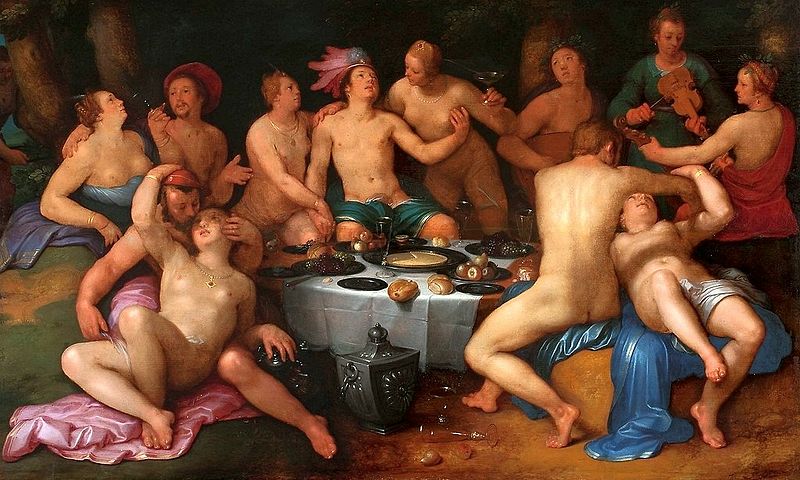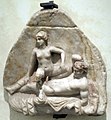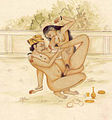Introduction

Pornography (colloquially known as porn or porno) is sexual subject material such as a picture, video, text, or audio that is intended for sexual arousal. Made for consumption by adults, pornographic depictions have evolved from cave paintings, some forty millennia ago, to modern virtual reality presentations. A general distinction of adults-only sexual content is made-classifying it as pornography or erotica.
The oldest artifacts considered pornographic were discovered in Germany in 2008 and are dated to be at least 35,000 years old. Throughout the history of erotic depictions, various people made attempts to suppress them under obscenity laws, censor, or make them illegal. Such grounds and even the definition of pornography have differed in various historical, cultural, and national contexts. The Indian Sanskrit text Kama Sutra (3rd century CE) contained prose, poetry, and illustrations regarding sexual behavior, and the book was celebrated; while the British English text Fanny Hill (1748), considered "the first original English prose pornography," has been one of the most prosecuted and banned books. In the late 19th century, a film by Thomas Edison that depicted a kiss was denounced as obscene in the United States, whereas Eugène Pirou's 1896 film Bedtime for the Bride was received very favorably in France. Starting from the mid-twentieth century on, societal attitudes towards sexuality became more lenient in the Western world where legal definitions of obscenity were made limited. In 1969, Blue Movie by Andy Warhol became the first film to depict unsimulated sex that received a wide theatrical release in the United States. This was followed by the "Golden Age of Porn" (1969–1984). The introduction of home video and the World Wide Web in the late 20th century led to global growth in the pornography business. Beginning in the 21st century, greater access to the Internet and affordable smartphones made pornography more mainstream. (Full article...)
Erotica is art, literature or photography that deals substantively with subject matter that is erotic, sexually stimulating or sexually arousing. Some critics regard pornography as a type of erotica, but many consider it to be different. Erotic art may use any artistic form to depict erotic content, including painting, sculpture, drama, film or music. Erotic literature and erotic photography have become genres in their own right. Erotica also exists in a number of subgenres including gay, lesbian, women's, monster, tentacle erotica and bondage erotica.
The term erotica is derived from the feminine form of the ancient Greek adjective: ἐρωτικός (erōtikós), from ἔρως (érōs)—words used to indicate lust, and sexual love. (Full article...)
Selected article
Marina Ann Hantzis (born 1988), known professionally as Sasha Grey, is an American actress, model, writer, musician, and former pornographic film actress. She began her acting career in the pornographic film industry, winning 15 awards for her work between 2007 and 2010, including the AVN Award for Female Performer of the Year in 2008. In 2023, she was inducted into the AVN Hall of Fame and the XRCO Hall of Fame.
After her 2009 feature film debut as the lead in Steven Soderbergh's The Girlfriend Experience, Grey starred in independent films including Open Windows, the Canadian black comedy horror film Smash Cut and the horror film Would You Rather. In 2011, she played a fictionalized version of herself in the HBO comedy-drama series Entourage.
Grey was a co-founder, singer, and writer of aTelecine, an industrial music band. She is the author of The Juliette Society trilogy of novels and also writes, directs, and co-produces films and music videos. (Full article...)
Selected work of erotic literature

Tijuana bibles (also known as eight-pagers, Tillie-and-Mac books, Jiggs-and-Maggie books, Jo-Jo books, bluesies, blue-bibles, gray-backs, and two-by-fours) were palm-sized erotic comics produced in the United States from the 1920s to the early 1960s. Their popularity peaked during the Great Depression era.
Most Tijuana bibles were obscene parodies of popular newspaper comic strips at the time, such as "Blondie", "Barney Google", "Moon Mullins", "Popeye", "Tillie the Toiler", "The Katzenjammer Kids", "Dick Tracy", "Little Orphan Annie", and "Bringing Up Father". Others made use of characters based on popular movie and sports stars of the day such as Mae West, W.C. Fields, Clark Gable, Joan Crawford, The Marx Brothers, Cary Grant, Jean Harlow, Babe Ruth, Lou Gehrig, and Joe Louis, sometimes with names only subtly changed. Before World War II, almost all the stories were humorous, cartoon versions of well-known dirty jokes that had been making the rounds for decades.
The artists, writers, and publishers of these booklets generally remained anonymous as their publication was illegal and clandestine. The quality of the artwork varied widely. The subjects consisted of explicit sexual escapades, usually featuring well-known newspaper comic strip characters, movie stars, and (rarely) political figures, invariably used without respect for either copyright or libel law and without permission. Tijuana bibles featured ethnic stereotypes found in popular culture at the time, although one Tijuana bible ("You Nazi Man") concluded on a serious note with a brief message from the publisher pleading for greater tolerance in Germany for the Jews. (Full article...)
List of selected works
|
|---|
Slideshow of selected contemporary images
Slideshow of selected historical images
Did you know (auto-generated) -

- ... that John Wayne Bobbitt Uncut was the bestselling pornographic film of 1994 and had the most rentals that year in the United States?
- ... that Nickelodeon storyboard artists created a book with hundreds of pornographic drawings of SpongeBob SquarePants characters?
- ... that a pornographic video service once offered NFL quarterback Gardner Minshew a one-million-dollar endorsement deal based on his habit of exercising in nothing but a jockstrap?
- ... that Koh Masaki was one of the first gay pornographic film actors in Japan to openly appear in adult films without obscuring his identity?
- ... that Claudia Riner was falsely accused of distributing lesbian erotica in the Kentucky House of Representatives?
- ... that Aroha Bridge changed its name from Hook Ups because fans searching for the show often found pornography instead?
- ... that the pastor John Littlejohn went from selling pornographic literature to sailors as a youth to protecting the Declaration of Independence?
- ... that in 2001, around 64 percent of all films produced in Malayalam were of the soft-porn variety?
Topics
Categories
Related portals
Associated WikiProjects
 |
 |
| Sexology and sexuality | Pornography |
Associated Wikimedia
The following Wikimedia Foundation sister projects provide more on this subject:
-
Commons
Free media repository -
Wikibooks
Free textbooks and manuals -
Wikidata
Free knowledge base -
Wikinews
Free-content news -
Wikiquote
Collection of quotations -
Wikisource
Free-content library -
Wikiversity
Free learning tools -
Wiktionary
Dictionary and thesaurus

















































































![Image 30Indian Princess, by Richard Borrmeister [de] (1888?)](http://upload.wikimedia.org/wikipedia/commons/thumb/0/01/Richard_Borrmeister_Indische_Prinzessin_1888.jpg/102px-Richard_Borrmeister_Indische_Prinzessin_1888.jpg)






















